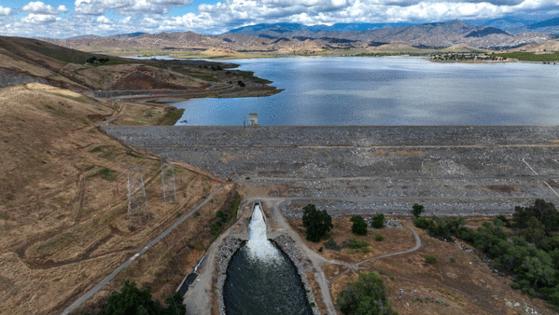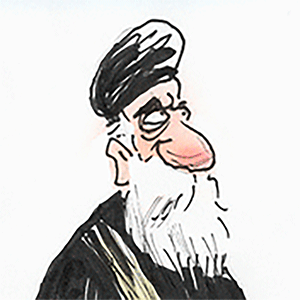The water unexpectedly released from dams on Trump's order didn't help farms or LA
Published in News & Features
LOS ANGELES — Days after President Trump startled some of his most ardent supporters in California’s San Joaquin Valley by having the Army Corps of Engineers suddenly release water from two dams, many in the region and beyond were still perplexed.
Acting on an order from Washington, the corps allowed irrigation water to flow down river channels for three days, into the network of engineered waterways that fan out among farm fields in the San Joaquin Valley. Coursing from rivers to canals to irrigation ditches, much of the water eventually made its way to retention basins, where it soaked into the ground, replenishing groundwater.
“It’s been recharged to the ground,” said Tom Barcellos, president of the Lower Tule River Irrigation District and a dairyman and farmer. That sounds good, except farmers in parts of the San Joaquin Valley typically depend on water from the two dams to irrigate crops in the summer. In other words, the release of water this time of year, when agriculture usually doesn’t require it, means that growers are likely to have less water stored in the reservoirs this summer, during a year that so far is among the area’s driest on record.
“It would have been better utilized if we could keep it there and use it this summer for irrigation,” Barcellos said. The loss of that water — equivalent to about two days of maximum water use during the summer irrigation season — amounted to “not a lot of harm, not a big foul,” he said.
Still, he said: “I believe someone in D.C. got a little overzealous.”
The sudden, unplanned release of water from the dams has led to criticism from some residents, water managers and members of Congress, who say the unusual discharge of water seems to have been intended to make a political statement — to demonstrate that Trump has the authority to order federal dams or pumps to send more water flowing as he directs.
“These kinds of shenanigans, they hurt smaller farmers,” said Dezaraye Bagalayos, a local water activist. Small growers have already been struggling, and the release of water from the dams means they will have less when they need it, Bagalayos said.
“The last thing in the world California water management needs is somebody like Trump calling shots when he doesn’t know how anything works,” Bagalayos said. “It’s making an already hard situation very, very difficult. We don’t have a lot of wiggle room in the state of California to be messing around with our water supply like this.”
The Army Corps of Engineers abruptly began releasing large flows on Friday, sending water streaming from Terminus Dam into the Kaweah River near Visalia and from Schafer Dam into the Tule River near Porterville. The high flows continued for a day, then lessened somewhat, and ended Sunday.
The action occurred after Trump’s visit to fire-devastated Los Angeles, when he pledged to “open up the valves” to bring the region more water — even though reservoirs that supply Southern California’s cities were at record levels (and remain so).
As the water poured from the dams, Trump posted a photo of one of them, saying it was “beautiful water flow that I just opened in California.” The Army Corps of Engineers said the action was “consistent with the direction” in Trump’s recent executive order, which calls for maximizing water deliveries.
Neither Trump nor the Army Corps of Engineers provided details about where the water was intended to go. But water released from the two dams serves agriculture in the eastern San Joaquin Valley. It typically does not reach the Los Angeles area, which depends instead on supplies delivered from the aqueducts of the State Water Project on the other side of the valley.
The water releases lowered the levels of the two reservoirs: Lake Success, near Porterville, had been about 20% full. It fell to 18%. Lake Kaweah, near Visalia, was roughly 21% full and similarly dropped to 19% of capacity over the weekend.
Federal records show that more than 2 billion gallons were released from the reservoirs over three days.
Peter Gleick, a water scientist and senior fellow at the Pacific Institute, said that “for a political photo op and a social media post, the Trump administration has thrown away billions of gallons of California water.” He said the water will not reach any city, “not be used or usable for firefighting, not be used by farmers since this isn’t the irrigation season, and won’t be saved for the dry season, which is coming.”
It was “a needlessly self-destructive action purely for political showmanship,” Gleick said.
“After Trump issued his executive order to do something about California’s water, it appears that Army Corps officials scrambled to respond,” Gleick said. “California’s water system is very delicately balanced among all of the competing interests, and this episode shows that even slight interference in that system can cause chaos.”
Local water managers said they were caught off-guard Thursday. Dan Vink, a water consultant who previously served as general manager of the Lower Tule River Irrigation District, called the situation “extremely unprecedented.”
A release of that magnitude, Vink said, would normally be coordinated days in advance. The local water managers on Thursday communicated their concerns to the Army Corps officials, who agreed to release less water than originally planned and to delay the releases until Friday, Vink said. Some water releases went ahead anyway.
The Army Corps of Engineers did not respond to a request for comment Monday about why the water releases were carried out and where the water went.
Barcellos’ Lower Tule irrigation district, together with the Tule River Association, Kaweah & St. Johns Rivers Association and Tulare Irrigation District, issued a joint statement Monday saying supplies in both reservoirs were being stored for the irrigation purposes of various users, to be distributed based on established water rights. According to the statement, the water has been “managed in cooperation with the Corps to achieve the combined benefits of both flood control and water supply for the region.”
The water districts said California’s water operations are “incredibly complex” and that the movement of water supplies “requires an extensive understanding of the plumbing, safety concerns, laws, and coordination among the various owners and operators of water and canals.” In their statement, they noted that Trump administration officials were in “close contact” with local experts and members of Congress “as critical decisions were being made.”
They said much of the water was used for groundwater recharge. Some water also flowed in ditches to nature areas, such as the Kaweah Oaks Preserve.
Gleick pointed out that the Tulare Basin is experiencing drought conditions. Since October, the region has had nearly record-low precipitation.
“It’s possible that this summer, we’re really going to wish we had that water back,” Gleick said. “We’re really going to wish we had the water that Trump ordered released, back in the reservoirs.”
Several Democratic members of Congress criticized the Trump administration’s decision and demanded answers.
“This sudden, uncoordinated move raises serious concerns for downstream agricultural operations and communities since local authorities had little time to adjust or plan accordingly,” Reps. Jared Huffman, D-Calif., and Rick Larsen, D-Wash., said in a letter to Defense Secretary Pete Hegseth and Interior Secretary Doug Burgum.
They said they are worried the releases “did not meet their stated intent of providing Los Angeles with additional water, and could reduce the availability of critical municipal and agricultural water supplies later in the year.”
They asked for information on who specifically — whether Trump or someone else — had given the order, if the Department of Government Efficiency was involved, and if officials had coordinated with state and local officials. (State officials have said they were not involved in the decision.)
“The public deserves clear answers to these questions and assurances that no similar actions will be taken in the future that jeopardize the safety of downstream communities,” or undermine local water planning, Huffman and Larsen said.
Rep. Jim Costa, a Democrat who represents parts of Tulare and Fresno counties, said he has “grave concern” about what occurred.
“An unscheduled release of water at this time of year, when there is little demand for irrigation water and a snowpack that is below average, poses grave threats to a reliable water supply this year,” Costa wrote in a letter to Hegseth. “In addition, this could increase the cost of water for farmers for this crop year exponentially due to dry conditions anticipated.”
Matt Hurley, general manager of the McMullin Area Groundwater Sustainability Agency, said he thinks the water releases were intended as a “political statement.”
“Will it help L.A.’s fire? No, absolutely not. But it will help groundwater,” Hurley said. And, he added, that’s one significant positive, as local agencies are focusing on recharging more water to address chronic overpumping that has caused declining water levels.
“From a groundwater manager’s point of view, getting any water in the ground is better than nothing.”
_____
©2025 Los Angeles Times. Visit at latimes.com. Distributed by Tribune Content Agency, LLC.







Comments